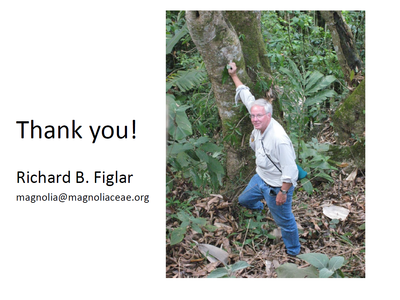Ex-situ cult. of magnolias in South Carolina facilitates observations of tepal movements during their 24-hour protogynous flowering cycles
RICHARD B. FIGLAR, Guest Speaker
Scientific Advisor - Magnolia Society International. Magnolian Grove Arboretum, 651 Newton Road, Pickens, South Carolina 29671.
Over a period spanning over 25 years, I have acquired over 50 species from 9 Sections (clades) of Magnolia and established them on part of the 8.1 hectare property of our home in western South Carolina. This ex-situ collection, known as Magnolian Grove Arboretum (MGA), has provided me with a unique living laboratory for making intensive and repetitive morphological observations during any time of day or night, over many years, and for many magnolia species. As a result, certain transient and/or impermanent morphological characters, which often cannot easily be detected during fieldwork or in the herbarium, were able to be observed and studied. Some of these, such as proleptic branching, played a role in justifying the reduction of genus Michelia into Magnolia in 2000. In another case, minute stipular scars (+0 to 2 mm long) at the base of the petioles, which had previously evaded detection, were revealed in many species that had been previously described as having no stipule scars, including M. grandiflora, M. tamaulipana and several species from Section Michelia. This living laboratory also allowed me to become familiar with anthesis times, stamen behavior and the associated nastic-like tepal movements of the 24 hour protogynous flowering cycles, i.e. opening (female phase), closing (inter-phase) and re-opening (male phase), for many species from 5 of these Sections. Hand pollinations were often performed to verify anthesis times, as well as to experiment with out-crossing between distantly related species from different Sections. After first presenting various examples of syllepsis, prolepsis, minute stipular scars and other elusive characters, I continue the presentation with sets of sequential photo-frames that animate the chronologies of these nastic tepal movements (and associated changes in stigma and stamen morphology) through the 24 hour protogynous flowering cycles for several species from four Sections: Magnolia, Gwillimia, Rhytidospermum and Manglietia here at MGA. These chronologies confirm an evening/night tepal-opening model for majority of spp. in Sections Gwillimia, Rhytidospermum, Manglietia and one species from Section Magnolia, while a morning/day tepal-opening model is suggested for all other spp. of Section Magnolia. Supplemented by additional photo-documentation obtained from colleagues (and via my own field trips), these flowering cycle chronologies are then compared with floral photo-evidence of various neotropical species from the Subsections of Section Talauma. These comparisons, though far from complete, seem to support an evening/night tepal-opening model for Subsection Talauma taxa and for one species of Subsection Chocotalauma, while a morning/day tepal-opening model is suggested for Subsections Cubenses and Dugandiodendron.
A preliminary key incorporating these characters, stipule scars and other characters is illustrated. Also, simple hand-pollination methods are described and illustrated which could be useful for practical and productive propagation of Magnolia spp. in ex-situ conservation.

